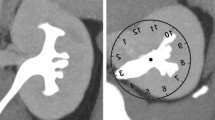Abstract
The authors analyzed the excretory urograms of 177 female children whose ages ranged from infancy to eleven years. The purpose of the study was to discover whether the upper pole calyx moves closer to the spine and the lower pole calyx moves closer to the ureter in the presence of calyceal clubbing and parenchymal scarring. This study confirms these observations but shows that considerable overlap occurs between normals and abnormals. This overlap is greatest in the younger age group and in the lower pole calyx to ureter measurements.
Similar content being viewed by others
References
Filly, R. A., Friedland, G. W., Govan, D., Fair, W.: Development and progression of clubbing and scarring in children with recurrent urinary infections. (Submitted to Radiology)
Williams, D. I.: In: Urology in childhood, p. 148. Berlin, Göttingen, Heidelberg: Springer 1958.
Williams, D. I.: Personal communication (1973).
Author information
Authors and Affiliations
Additional information
Academic Trainee in Diagnostic Radiology. Supported by grant GM 1707 of the National Institute of General Medical Sciences, National Institutes of Health, USPHS.
Rights and permissions
About this article
Cite this article
Friedland, G.W., Filly, R. & Brown, B.W. Distance of upper pole calyx to spine and lower pole calyx to ureter as indicators of parenchymal loss in children. Pediatr Radiol 2, 29–37 (1974). https://doi.org/10.1007/BF00972844
Issue Date:
DOI: https://doi.org/10.1007/BF00972844




